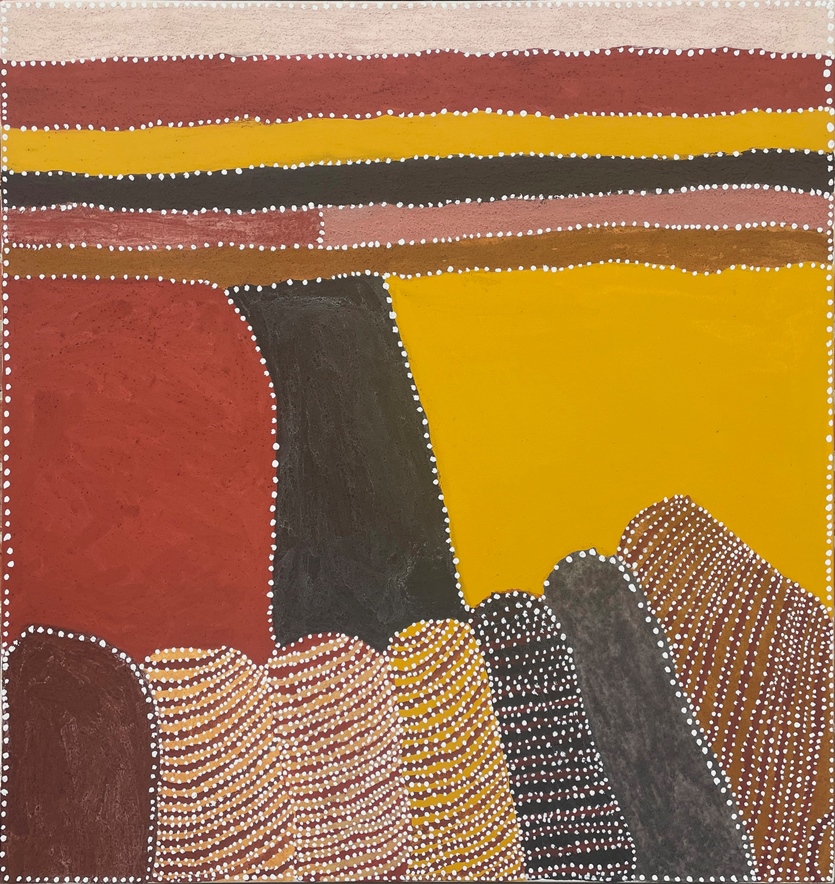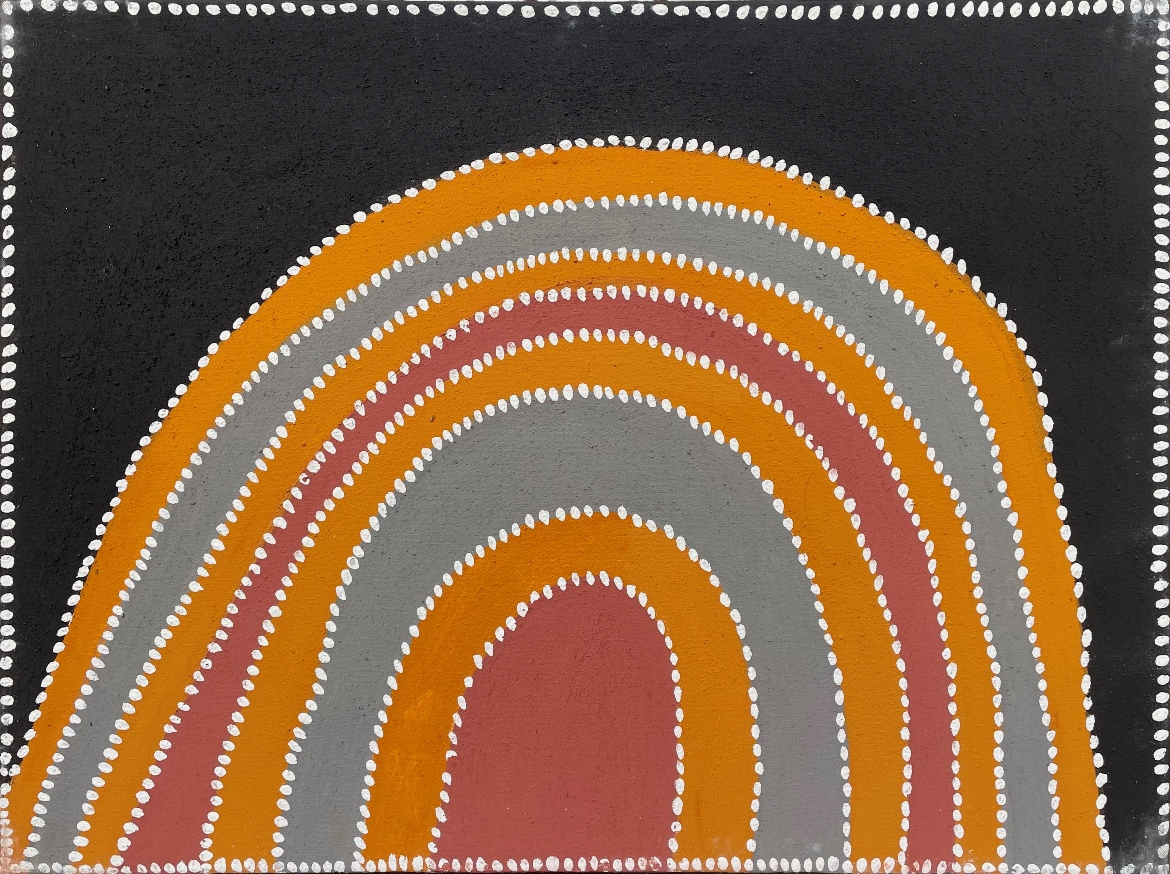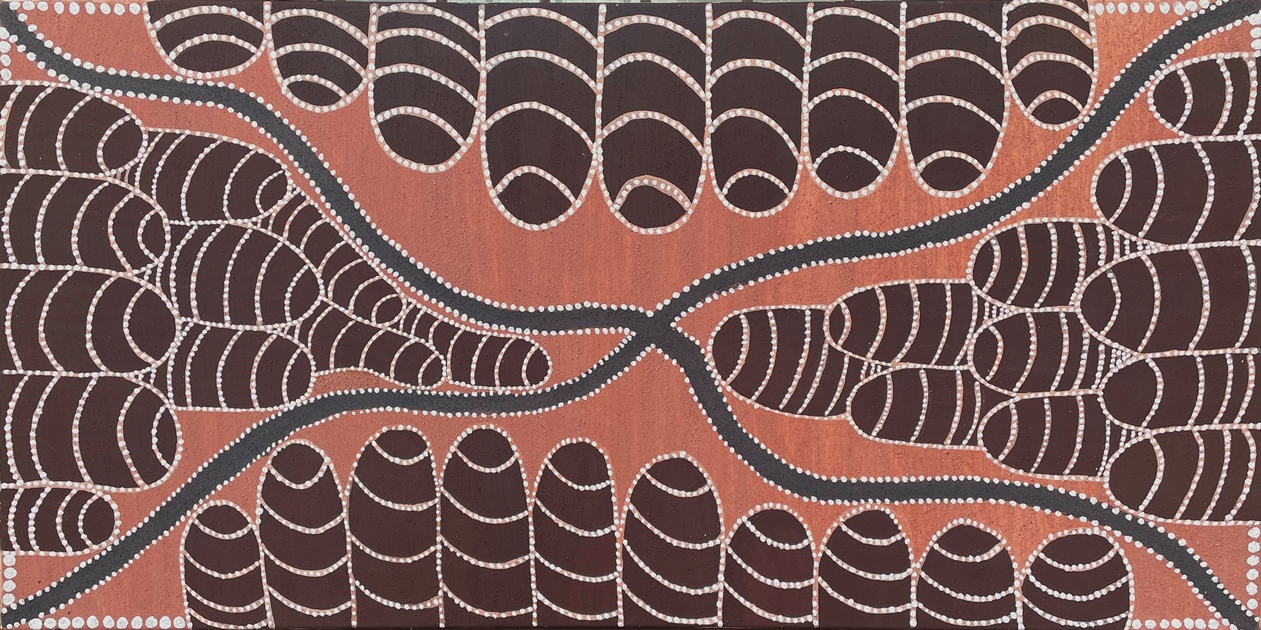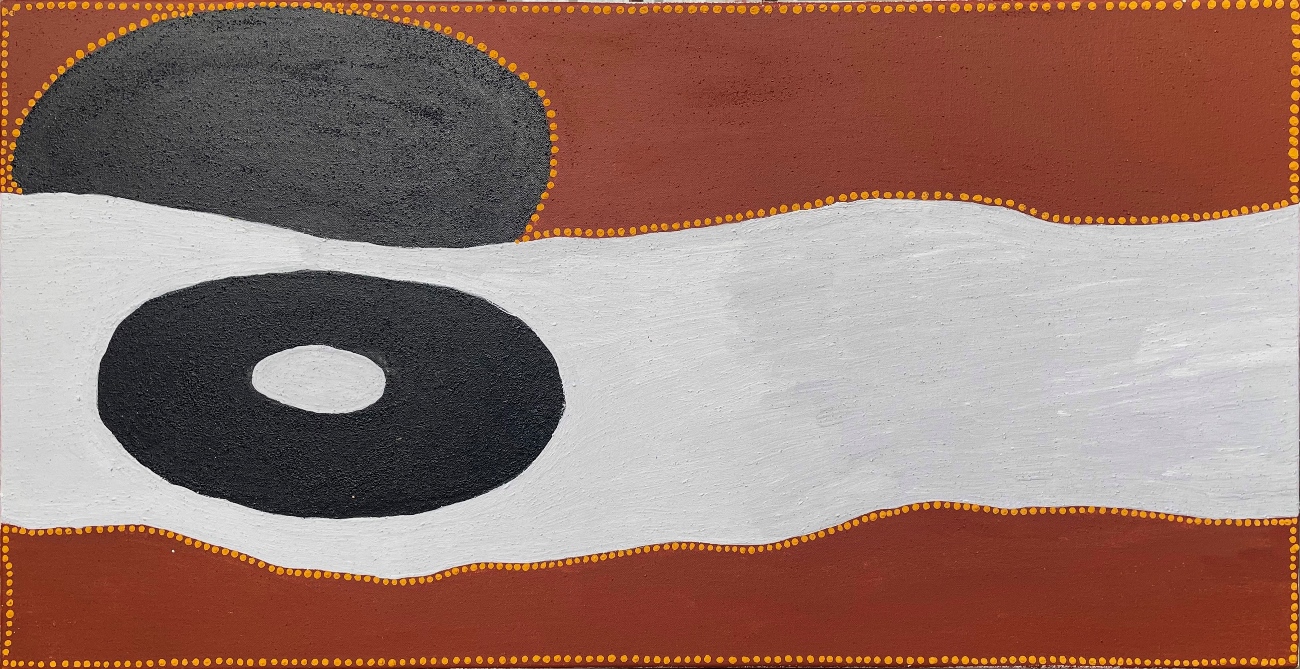Five Generations Painting at Warmun Arts Centre
Mayrav (Ravi) is the General Manager at Warmun Art Centre. In this article, she explains why Warmun is such an extraordinary art centre, and the birthplace of the contemporary Aboriginal art movement. She discusses how ochre is found and used in the art and the urgency of preserving traditional knowledge.


Top Feature Image: Roberta Daylight | Purnululu | Jap 022725
Warmun community is situated in one of the most desired locations and is amongst the most travelled. It is surrounded by breath-taking beauty, such as the glorious Bungles Bungles—Purnululu National Park, numerous creeks, rivers, healing springs and waterholes, Gibb River Road, Fitzroy Crossing and many more attractions.
We have many visitors come to our centre. From the very first moment they walk in, they discover that they walked into a place like no other. Warmun is unique for quite a few reasons.
First Art Centre
Warmun Art Centre was established only in 1998, which is not a long time compared to the First Nation people's history. However, Warmun Arts Centre has had a huge impact nationally and worldwide.
Run by Community, To Keep Culture Alive
The contemporary Aboriginal art movement started here. In 1998, five of our now-deceased co-founders recognised the need for a centre like this, which would be community-led and community-owned, where all the profits go back to the community. It would be a space that can preserve, protect, and maintain Gija culture, language, traditions, and ceremonies. It would encourage the younger generations to follow in the footsteps of their ancestors, keeping Gija culture alive for many more generations to come.
The five co-founders I'm referring to are Rover Thomas, Queenie Mackenzie, Hector Jandaloo(Jandany), Madigan Thomas, and Jack Britten. Those are the guiding stars who started this place. Each has a huge life story and life journey that touched and inspired so many in Australia and worldwide.
Art As A Way To Transfer Knowledge
Aboriginal people didn't have books or a written language (per se) in the past. Their knowledge was transferred through trading, corroborees, ceremonies, singing or dancing, and the arts. There were paintings in caves, on animal skin, on wood, or in carving. In modern times, it's on canvas, but painting, storytelling, and song trails have always been how the First Nation people transferred and shared their knowledge. That's how they ensured that what was passed to them was passed forward.
Five Generations Painting
We have 66 active artists working through the centre. The community has a fluctuating population of between 350 and 500 (if everyone is here). In the gallery, we represent up to five generations of artists. The youngest one is only nine years old, and recently, we discovered another young one who's seven years old and is producing beautiful artwork.
The five generations belong to the Purdie family, starting with Madigan Thomas, then Shirley Purdie, Shirley Purdie's daughter, Madeline Purdie, and her daughter, Tatum Rivers Purdie, and then Madeline’s granddaughter/Shirley’s great-granddaughter, Kendall Morgan. Witnessing how the old people pass on their knowledge and stories to the young is a privilege.
Only Gija Custodians Can Share Gija Stories
With Gija artists, you can't separate the culture from the artwork. Art is a direct representation of culture and country. Gija country is huge. Within that vastness, you have different boundaries and family units who are the custodians, protectors, healers, and storytellers for that part of the country. They are all Gija people, all Gija language groups, but there are different areas within the vast region it covers.
Only these people are allowed to share the stories from their area of the land. It's not respectful to share someone else's story. So, the artists tell different Dreamtime stories. These include the history of that land and the knowledge that comes specifically from that area. It might be bush medicine, bush tucker, or how to survive and thrive in those landscapes with their very harsh conditions, how to live life to its fullest.
Long History Using Ochre
The Gija people still use traditional ochres from Gija country and the East Kimberley region. The ochre is harvested by hand. We bring chunks of big, coloured ‘rocks’ that are then broken down into pieces and crushed by hand, one by one, to make the pigments that the artists use.
Those pigments are either used as is or combined between them to create more colours, or where the magic happens when they heat them or "cook’em up". The pigments within the pigments will surface and come out. So yellow becomes a bright orange, and shades and tones of green and light blue/grey are developed. You'll even see purple.
They are magicians at using the resources around them and applying them to canvas. They believe they are not only sharing a part of their story, history, and culture, but they're also sharing a piece of their land with every single artwork sold, which is a huge gift.
Textured Art From The Earth
The artworks themselves have texture because the artists use materials from the land. Some like the paint surface to be rough and textured, and others like it smooth and soft. Amazingly, a diversity of artwork can be created with the same material.

Dealing With A Traumatic Past
In terms of subject matter, the artists share stories of their culture and the very core of their identity, as well as their stories of who they are as people.
The East Kimberley region is known as one of the worst, most brutal massacre sites that occurred in Australia. The areas that are more spoken about are Mistake Creek, Bedford Downs, Chainaman Garden, and the Queensland River, which is next to Springvale. Those are presented here in the gallery. It's not only the Dreamtime stories. It's far more than that.
The Wish To Come Together
Not once in all the time that I've been working with and for the First Nation people have I ever heard a word of hate, not once. There's a lot of pain and trauma, yet no words of hate or anger. Instead, there is this wish to come together, to work as one. The people in this community wish to be acknowledged and respected. They wish to embrace diversity instead of fighting it or trying to label, tag, and separate.
The Gija people are also very well known for that. They are interested in two-way learning and bringing the traditional ways and the Kardiya (White people)/ Western society way, across everything here. It's in school, when we go out on country, do activities, speak the language and teach. There can be strength in bringing both together; everything is presented in both ways. Even the traditional stories are retold in a contemporary way, using traditional materials, but with the up-to-date surface of the canvas.
Big Hearted People
I feel overwhelmed daily by these people. Their kindness and generosity. Their huge hearts, willingness, and openness to take you in and share. Sometimes, when I sit with the older women when they paint or with Patrick, it feels like I need to hold an imaginary basket. They throw these beautiful gems of memories, stories, songs, and things that just come up as they paint. I feel so very lucky to experience these things.
Mawoondool - White Ochre Outline
The two materials are a little bit different from the other ochres. One of them, in language, is called Mawoondool- The white ochre. It's the first time I've ever seen anything like it. It's found deep in the ground, right next to the river. The digging takes place, and they can't eat or drink during that time. They are fully present at that moment. They do a ceremony before they begin digging. After they finish, they cover everything up and conduct another ceremony to thank the ancestors of the land and Mother Earth for what it provided.
You can only harvest a certain amount because Mother Earth will not provide if you become greedy. The Mawoondool is more precious than gold. This material is rare and can only be found in Gija country. It is used in their paintings as the outline—the "dot—dot," as they call it.
This is unlike other language groups, where they use dots as the main element. Here, it's just the outline around the image. For them, it's the DNA. It's the very source, the code of their culture. Every dot has a meaning. Every dot has a purpose. It's a song trail, as well as that definition. This material is also used for ceremonies and body paint. So, it is a very special and sacred material.

Charcoal With A Sparkle
This important material is charcoal. It can't be just any charcoal. It has to be from a specific tree that grows in specific areas where we visit. The wood is cut and brought to the gallery. There is so much respect, appreciation, love, care, and attention to detail.
There's a whole process to get the charcoal to a place where they can crush it and make the material or pigment they use in their paintings. When it's on the painting, it has a natural sparkle. It's like you put a night sky onto the canvas. I find it quite miraculous, majestic, and truly magical.
The Sense of Urgency In The Face of Losing Elders
There's a great sense of urgency these days around preserving culture. This is because we're losing more and more elders. We have very few left here in this community. It can't be more critical to ensure the passing on of knowledge. We've been very busy creating more opportunities, platforms, cultural activities, and language programmes that are directed, guided, mentored, and facilitated by the elders that we have and the board of directors—the local governance and cultural leadership.
So Much More Than An Art Centre
This place is not only an art centre. It is the heart and soul of Gija Culture and the centre of the community. This is where the old people come and where everything begins and ends.
Every Tuesday, we have an artist meeting, which is something that has been making way before I arrived. We discuss all matters, events, celebrations, challenges, requests, ideas, and suggestions. These meetings are very proactive, vibrant and full of life. This is something that we treasure and is unique to this place. It's quite beautiful to be part of it.
(Mr. Patrick Mung Mung, one of the Elders, arrives.)
Q. How do you feel seeing all the young ones coming in with their art and stories? What's that like for you?
Patrick: “Good. That makes me feel better. I like to see that happen. I'm a bushman, I can't read, but I know the country from all of my life. from when I was little. I just grew up in this place. I'd walk and ride in this country back in those days. It was a long time ago when there was none of this. Yeah, my generation of old people have been with me out in the bush, and they used to tell me, "This has got to be yours." When we all gone, my money, all left. That's why I like to see this happen before I go.”
Purnululu - Theme of the New Exhibition
The upcoming Japingka exhibition focuses on Purnululu, which means a lot of beehives in the shape of a mountain. There is a story about it: if the wrong person is in the wrong place, it can turn around and become a big maze, and people can get lost. Now, for Gija people, they know exactly where to go and what to look for.
They know exactly where to go and what to do, when they're out, what kind of bush tucker is around and in the seasons, what to look for, what kind of changes happen in the country, and the signs for them. They see much more than meets the eye.
There are also important birds in this place's stories: the wedgetail eagle and the crow. It's believed that the crow is the one that gives the gifts to the children, and this is the story painted by our youngest artist.
Saving The Precious Art
In 2011, huge floods destroyed 76 houses. In the art centre, the water almost reached the ceiling level, washing away 600 of the artworks. When the people came back from emergency evacuation and started rebuilding their lives, their community, and their homes, they walked out looking for the artworks. They knew the country so well that they found paintings everywhere: in trees, in bush, in creeks. They managed to find 400 artworks that were flushed with the water and brought them back here.
For five years, the elders, artists and community members worked closely with a group of experts from Melbourne University to restore those paintings. They are our closest allies and partners, and our strong relationships and connections have been maintained.
All of the 400 artworks were restored. Some are kept in museums and galleries nationally and internationally. They are considered national treasures, and our private community collection is here.
It doesn't matter what comes these people's way, how hard it goes or how painful it is. They rise above. Their hearts are always big. I've never come across such generosity and such warm hearts. You’ll feel that in the art, the very spirit of the people and the Gija Culture.

